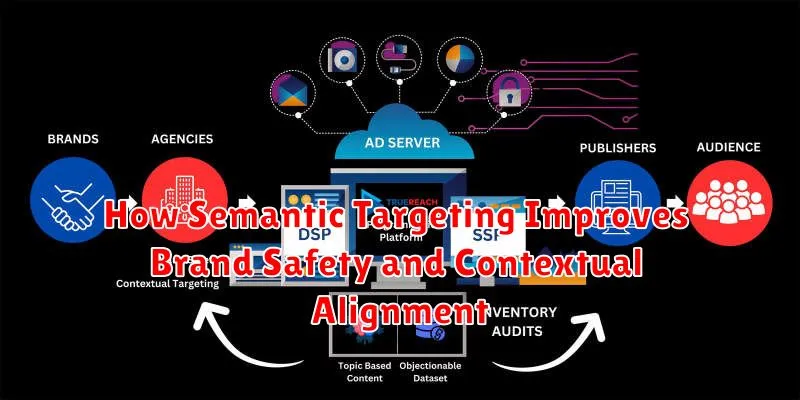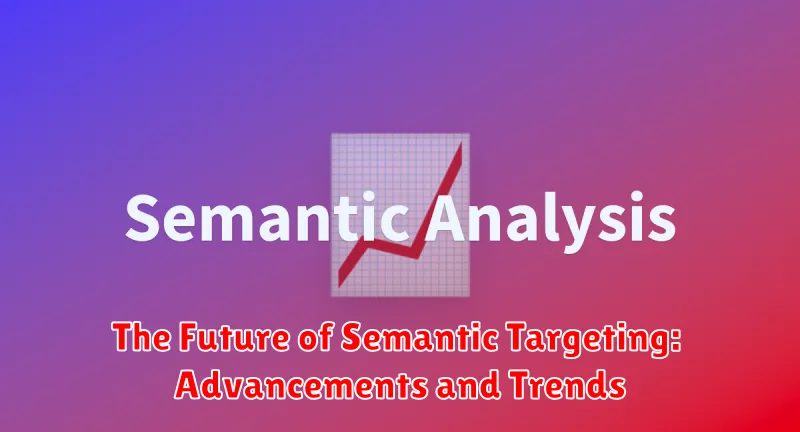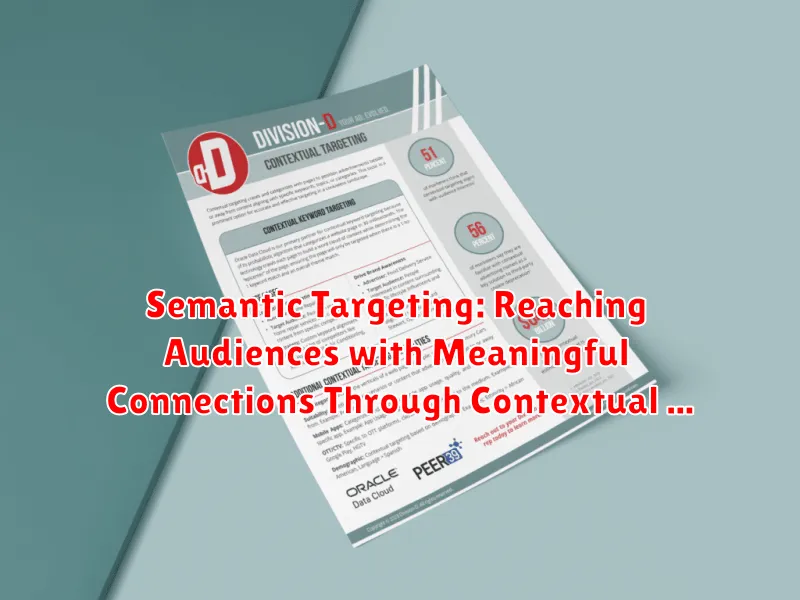In the ever-evolving landscape of digital advertising, the quest for precision and meaningful connections with audiences is paramount. Semantic targeting emerges as a powerful strategy, transcending traditional demographic and behavioral approaches. It focuses on understanding the contextual meaning of content, enabling advertisers to reach users whose interests and intentions align with the message being conveyed. This advanced form of contextual advertising moves beyond simple keyword matching, delving into the nuances of language and the underlying themes of web pages and articles. By leveraging semantic understanding, brands can deliver highly relevant and engaging ads, ultimately driving superior performance and fostering stronger relationships with their target audiences.
This article delves into the core principles of semantic targeting and its potential to revolutionize digital marketing strategies. We will explore how semantic analysis algorithms work, examining the methods used to decipher the meaning behind text and identify the key concepts and entities discussed. Furthermore, we will compare semantic targeting to other targeting methods, highlighting its advantages in terms of relevance, user experience, and brand safety. Through real-world examples and case studies, we will illustrate how businesses across various industries can effectively implement semantic targeting to achieve their marketing objectives and establish more authentic connections with their desired customer base on a global scale.
What is Semantic Targeting and How Does It Differ from Keyword Targeting?
Semantic targeting represents a sophisticated approach to online advertising that focuses on understanding the meaning and context of web pages to match ads with relevant content. Unlike traditional keyword targeting, which relies solely on the presence of specific words, semantic targeting uses Natural Language Processing (NLP) and machine learning to analyze the overall theme and sentiment of a webpage.
The core difference lies in depth of analysis. Keyword targeting might display an ad for “apple pie” on a page mentioning “apple” in the context of a tech company. Semantic targeting, however, understands the article is about technology, not baking, and would avoid the irrelevant ad.
Here’s a brief comparison:
- Keyword Targeting: Matches ads based on the presence of specific keywords.
- Semantic Targeting: Matches ads based on the meaning and context of the content.
In essence, semantic targeting strives to create more relevant and engaging ad experiences by going beyond simple keyword matching.
The Technology Behind Semantic Targeting: Natural Language Processing (NLP) and Machine Learning
Semantic targeting hinges on sophisticated technologies, primarily Natural Language Processing (NLP) and Machine Learning (ML). These technologies empower systems to understand the meaning and context of online content, going far beyond simple keyword matching.
NLP algorithms analyze text to extract key entities, sentiments, and relationships between words and phrases. This allows the system to discern the subject matter and the intent behind the content. For example, an NLP model can differentiate between an article discussing apple pie and an article comparing different brands of apples.
Machine Learning algorithms are then used to refine and scale this understanding. By training on vast datasets, ML models learn to classify content into relevant categories and predict user interests with increasing accuracy. These models are constantly learning and adapting, improving the precision of semantic targeting over time. Through this dynamic process, advertising can be served to users engaging with highly relevant content.
Benefits of Using Semantic Targeting for Enhanced Ad Relevance
Semantic targeting offers significant advantages in enhancing ad relevance. By understanding the context and meaning behind content, ads can be precisely matched to user interests, leading to improved engagement and conversion rates.
Here are some key benefits:
- Increased Ad Relevance: Delivers ads that are highly relevant to the content being consumed, improving user experience.
- Higher Engagement Rates: More relevant ads capture user attention and encourage interaction.
- Improved Conversion Rates: By targeting users with the right message at the right time, conversion rates are significantly boosted.
- Reduced Ad Waste: Ensures that ads are shown to users who are genuinely interested in the product or service being advertised.
Ultimately, semantic targeting fosters a more meaningful connection between brands and their target audiences, resulting in more effective and efficient advertising campaigns.
How Semantic Targeting Improves Brand Safety and Contextual Alignment

Semantic targeting significantly enhances brand safety by ensuring ads appear within contexts that align with a brand’s values and reputation. Traditional methods, relying on keyword blocking, often prove inadequate, leading to ads appearing alongside inappropriate or controversial content.
By leveraging Natural Language Processing (NLP) and machine learning, semantic targeting analyzes the meaning and sentiment of web pages, articles, and videos. This allows for a deeper understanding of the content, going beyond simple keyword matching to identify potentially harmful or misaligned environments.
This contextual understanding ensures that ads are placed in environments that are not only relevant but also safe and appropriate for the brand, minimizing the risk of negative associations and protecting brand image. This approach also provides a higher degree of contextual alignment, ensuring the message resonates with the audience in a meaningful and positive way.
Semantic Targeting Strategies for Different Content Types
Semantic targeting’s adaptability allows for customized strategies based on the content’s nature. Understanding the nuances of various content types is crucial for effective campaign execution.
News Articles
For news articles, focus on extracting the core event, involved entities (people, organizations, locations), and sentiment. Target users interested in similar past events or those with affiliations to the identified entities. This delivers highly relevant ads within the context of current affairs.
Blog Posts and Tutorials
When dealing with blog posts or tutorials, identify the skill or topic being taught. Target users actively seeking to learn or improve in that specific area. Ads promoting tools or services related to the content’s subject matter will resonate strongly with the reader.
Product Reviews
For product reviews, use semantic analysis to pinpoint the product’s features, strengths, and weaknesses mentioned in the review. Target users researching similar products or those with specific needs highlighted in the review. Ads offering alternative products or accessories can be strategically placed.
Implementing Semantic Targeting in Programmatic Advertising Campaigns
Implementing semantic targeting within programmatic advertising campaigns allows for a more nuanced and effective approach to reaching desired audiences. This involves integrating semantic analysis capabilities into your Demand-Side Platform (DSP) or leveraging third-party semantic targeting solutions that can be layered on top of existing programmatic infrastructure.
Key considerations include:
- Data Integration: Ensure seamless data flow between your DSP and semantic analysis provider to enable real-time content analysis and ad placement.
- Contextual Understanding: Configure your campaign settings to prioritize ad placements on pages with high semantic relevance to your target keywords.
- Audience Segmentation: Utilize semantic insights to create granular audience segments based on content consumption patterns and user interests.
- Bid Optimization: Adjust your bidding strategies based on the performance of semantic targeting segments to maximize ROI.
By thoughtfully integrating semantic targeting, advertisers can ensure their messages resonate with receptive audiences within appropriate contexts, leading to improved engagement and conversion rates.
Measuring the Performance of Semantic Targeting: Key Metrics
Evaluating the effectiveness of semantic targeting requires tracking specific key performance indicators (KPIs). These metrics provide insights into the efficiency of reaching the intended audience and achieving campaign objectives.
Essential Metrics for Semantic Targeting Campaigns
- Click-Through Rate (CTR): Measures the percentage of users who click on the ad after seeing it, indicating ad relevance to the content.
- Conversion Rate: Tracks the percentage of users who complete a desired action (e.g., purchase, sign-up) after clicking the ad, reflecting the ad’s effectiveness in driving conversions.
- Engagement Metrics: Includes time spent on page, bounce rate, and social shares, indicating the quality of user interaction with the content and ad.
- Reach and Frequency: Monitors the number of unique users exposed to the ad and the average number of times each user sees it, ensuring optimal ad exposure.
- Cost Per Acquisition (CPA): Calculates the cost associated with acquiring a customer or lead, providing insights into campaign ROI.
Analyzing these key metrics allows for data-driven optimization and refinement of semantic targeting strategies, ensuring maximum impact and return on investment.
Examples of Successful Semantic Targeting Campaigns
Several brands have successfully implemented semantic targeting to achieve enhanced campaign performance and reach their desired audiences more effectively. Here are a few illustrative examples:
Example 1: Automotive Industry
A leading automotive manufacturer sought to promote their new electric vehicle. Instead of relying solely on keyword targeting related to “electric cars,” they employed semantic targeting to identify articles discussing environmental sustainability, renewable energy, and future transportation trends. This allowed them to reach a highly relevant audience interested in the broader context of their product’s benefits.
Example 2: Financial Services
A financial services company aimed to increase awareness of their retirement planning services. They used semantic targeting to target content discussing topics such as long-term financial security, investment strategies, and retirement lifestyle planning, rather than solely focusing on keywords like “retirement” or “401k.” This broader contextual approach enabled them to engage with individuals actively considering their future financial needs.
Example 3: Healthcare
A pharmaceutical company promoting a new allergy medication utilized semantic targeting to identify online articles and forums discussing seasonal allergies, pollen forecasts, and related health issues. This allowed them to connect with individuals actively seeking information and solutions related to their allergy symptoms.
The Future of Semantic Targeting: Advancements and Trends

The future of semantic targeting is poised for significant growth and innovation, driven by advancements in artificial intelligence (AI) and natural language processing (NLP). We can expect more sophisticated algorithms capable of discerning nuanced meanings and intent, leading to even more relevant and engaging ad experiences.
Here are some key trends shaping the future:
- Enhanced Contextual Understanding: NLP models will continue to improve, allowing for a deeper understanding of content beyond simple keyword analysis. This includes sentiment analysis, entity recognition, and topic modeling.
- Personalization at Scale: Semantic targeting will enable highly personalized ad experiences based on individual user interests and preferences, inferred from the content they consume.
- Integration with Emerging Technologies: Semantic targeting will be integrated with technologies such as voice search, augmented reality (AR), and virtual reality (VR) to create immersive and contextually relevant advertising opportunities.
- Improved Transparency and Control: Advertisers will gain greater control over where their ads appear and the context in which they are shown, ensuring brand safety and alignment with their values.
These advancements will empower marketers to connect with audiences in more meaningful ways, delivering relevant messages that resonate and drive results.
Best Practices for Optimizing Your Semantic Targeting Approach
To maximize the effectiveness of semantic targeting, consider these best practices:
Refine Your Content Categories
Ensure your content categories are granular and accurately reflect the nuances of your target audience’s interests. Precise categorization allows for more relevant ad placement.
Continuously Monitor and Analyze Performance
Regularly assess the performance of your semantic targeting campaigns using key metrics such as click-through rates and conversion rates. Data-driven insights will help you refine your strategy.
Utilize Exclusion Lists
Employ exclusion lists to prevent your ads from appearing in contexts that are irrelevant or harmful to your brand. This ensures brand safety and prevents wasted ad spend.
Test and Iterate Your Approach
A/B test different semantic targeting parameters, such as keyword combinations and contextual signals, to identify the most effective strategies for your specific campaign goals. Ongoing optimization is crucial.

